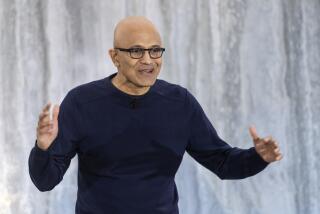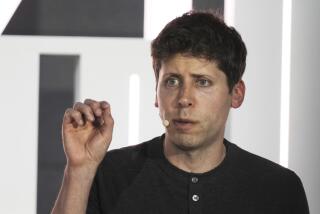Cray Drops Computer Venture as Too Risky; Top Researcher Resigns
- Share via
In a dispute over money and science that sent shock waves through the world of supercomputers, industry leader Cray Research announced that one of its two top designers is quitting the company and taking with him plans for an advanced new machine.
Cray said that Steven Chen, 44, who along with company namesake Seymour Cray has headed its fast-paced development work on the next generations of supercomputers, plans to take with him perhaps one-third of the 180 to 200 people who report to him on the “MP project.”
The company said from its Minneapolis headquarters that the project had grown too risky and too large. Once the company put the brakes on the project, which was due to enter production in the early 1990s, Chen decided to resign.
Cray said Chen plans to leave “in the very near future and expects to reconstitute the project outside of Cray Research. . . . Some people involved in the project may join him.”
Many investors saw the surprise announcement as a blow to Cray, the leading commercial producer of the world’s fastest breed of computers. Cray’s stock plummeted by $8.50 per share to $104.50 on heavy trading on the New York Stock Exchange.
Company Has ‘Ammunition’
But analysts disagreed on the seriousness of Chen’s departure, some arguing that the MP project was technologically an unknown quantity and becoming a bottomless pit for the company’s research and development budget.
“I don’t think it’s a serious setback for the company,” said James Berdell, a longtime follower of Cray and venture capitalist with Venture Growth Associates in San Francisco. “Steve Chen is a very talented designer, but this company has a lot of ammunition. The stock is a hell of a lot more attractive today than it was yesterday.”
Analyst Jeffrey Canin of the Hambrecht & Quist brokerage firm in San Francisco said the biggest risk to Cray could be damage to the management structure, depending on which and how many employees follow Chen to set up a new company.
“It’s tough to extract any good from this,” Canin said. “There will be reverberations in the management system.”
Chen was in meetings at Cray’s research and development laboratories in Chippewa Falls, Wis., and couldn’t be reached for comment.
The notion of trouble at Cray has more than corporate significance because of the company’s international success in the hotly competitive supercomputer field. It is one of a limited number of technology areas where a U.S. company maintains a clear commercial lead. The Chen project used a type of computer design known as parallel processing, a departure from the norm for Cray.
With parallel processing, complex problems are broken down and sent to several processors in a single computer. Conventional computers solve problems with one processor. Parallel processing is expected to speed the way computers work.
Cray Chairman John Rollwagen said the MP project, one of Cray’s three major development projects, “has grown significantly beyond our original vision, both in terms of technological risk and budget, and we believe that it no longer meets the objectives or style of Cray Research.”
A company spokesman, Robert Gaertner, described it as a “painful” but “amicable” parting of the ways. As evidence, he noted that Cray wouldn’t seek to block Chen’s independent development of the MP, “even though everything he is bringing with him is ours.”
CRAY RESEARCH AT A GLANCE The Minneapolis company is the world’s leading manufacturer of supercomputers--large, high-speed computer systems used mainly in scientific and engineering applications.
6 mos. Year ended ended Dec. 31 June 30, 1987 1986 1985 1984 (in millions) Revenue 339 597 380 229 Net Income 77 125 76 45
Assets $700 million Employees 4,000 Shares outstanding 30.4 million 52-week price range (NYSE) $69-$135.75 Wednesday’s close. $104.50, down $8.50






